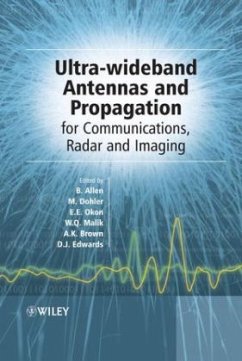Nicht lieferbar

Antennas for Global Navigation Satellite Systems
Versandkostenfrei!
Nicht lieferbar
This book addresses the fundamentals and practical implementations of antennas for Global Navigation Satellite Systems (GNSS)In this book, the authors discuss the various aspects of GNSS antennas, including fundamentals of GNSS, design approaches for the GNSS terminal and satellite antennas, performance enhancement techniques and effects of user's presence and surrounding environment on these antennas. In addition, the book will provide the reader with an insight into the most important aspects of the GNSS antenna technology and lay the foundations for future advancements. It also includes a n...
This book addresses the fundamentals and practical implementations of antennas for Global Navigation Satellite Systems (GNSS)
In this book, the authors discuss the various aspects of GNSS antennas, including fundamentals of GNSS, design approaches for the GNSS terminal and satellite antennas, performance enhancement techniques and effects of user's presence and surrounding environment on these antennas. In addition, the book will provide the reader with an insight into the most important aspects of the GNSS antenna technology and lay the foundations for future advancements. It also includes a number of real case studies describing the ways in which antenna design can be adapted to conform to the design constraints of practical user devices, and also the management of potential adverse interactions between the antenna and its platform.
Key Features:
Covers the fundamentals and practical implementations of antennas for Global Navigation Satellite Systems (GNSS)
Describes technological advancements for GPS, Glonass, Galileo and Compass
Aims to address future issues such as multipath interference, in building operation, RF interference in mobile
Includes a number of real case studies to illustrate practical implementation of GNSS
This book will be an invaluable guide for antenna designers, system engineers, researchers for GNSS systems and postgraduate students (antennas, satellite communication technology). R&D engineers in mobile handset manufacturers, spectrum engineers will also find this book of interest.
In this book, the authors discuss the various aspects of GNSS antennas, including fundamentals of GNSS, design approaches for the GNSS terminal and satellite antennas, performance enhancement techniques and effects of user's presence and surrounding environment on these antennas. In addition, the book will provide the reader with an insight into the most important aspects of the GNSS antenna technology and lay the foundations for future advancements. It also includes a number of real case studies describing the ways in which antenna design can be adapted to conform to the design constraints of practical user devices, and also the management of potential adverse interactions between the antenna and its platform.
Key Features:
Covers the fundamentals and practical implementations of antennas for Global Navigation Satellite Systems (GNSS)
Describes technological advancements for GPS, Glonass, Galileo and Compass
Aims to address future issues such as multipath interference, in building operation, RF interference in mobile
Includes a number of real case studies to illustrate practical implementation of GNSS
This book will be an invaluable guide for antenna designers, system engineers, researchers for GNSS systems and postgraduate students (antennas, satellite communication technology). R&D engineers in mobile handset manufacturers, spectrum engineers will also find this book of interest.













